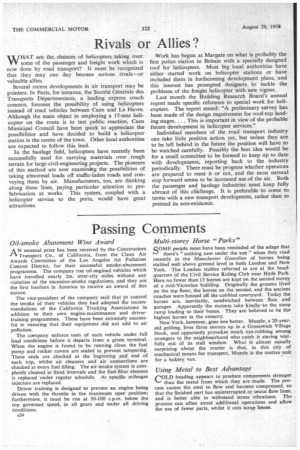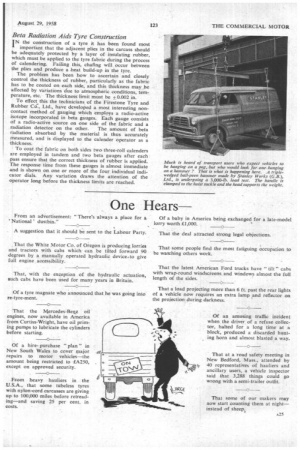Passing Comments
Page 26

Page 27

If you've noticed an error in this article please click here to report it so we can fix it.
Oil-smoke Abatement Wins Award
AN unusual prize has been received by the Constructors Transport Co., of California, from the Clean Air Awards Committee of the Los Angeles Air Pollution Control District, for their successful smoke-abatement programme. The company run oil-engined vehicles which have travelled nearly 2m. inter-city miles without any violation of the excessive-smoke regulations, and they are the first hauliers in America to receive an award of this nature.
The vice-president of the company said that to control the smoke of their vehicles they had adopted the recommendations of the California Trucking Associations in addition to their own engine-maintenance and drivertraining programmes. These have been extremely successful in ensuring that their equipment did not add to air pollution.
The company enforce tests of each vehicle under. full load conditions before it departs from a given terminal. When the engine is found to be running clean the fuel pump and rocker covers are sealed to prevent tampering. These seals are checked at the beginning and end of each trip, whilst air cleaners and air connections are checked at every fuel filling. The air-intake system is completely cleaned at fixed intervals and the fuel-filter element is replaced under regular schedule. At specific mileages injectors are replaced.
Driver training is designed to prevent an engine being driven with the throttle in the maximum open position; furthermore, it must be run at 50-100 r.p.m. below the top governed speed, in all gears and under all driving conditions.
A24
Multi-storey Horse "Parks"
SOME people must have been reminded of the adage that there's "nothing new under the sun" when they read recently in the Manchester Guardian of horses being stabled well above ground level in both London and New York. The London stables referred to are at the headquarters of the Civil Service Riding Club near Hyde Park. Here no fewer than 13 horses are kept on the second storey of a mid-Victorian building. Originally the grooms lived on the top floor, the horses on the second, and the ancient coaches were housed off the cobbled courtyard. Today the horses are, inevitably, sandwiched between flats and garages. Apparently the mounts take kindly-to the steep ramp leading to their boxes. They are believed to be the highest horses in the country.
New York, however, goes one better. Muzzle, a 20-yearold gelding, lives three storeys up in a Greenwich Village block, and apparently provokes much eye-rubbing among strangers to the neighbourhood who catch it staring wistfully out of its stall window. What is almost equally surprising about the matter is that, in this city of mechanical means for transport, Muzzle is the motive unit for a bakery van.
Using Metal to Best Advantage
COLD heading appears to produce components stronger "-d than the metal from which they are made. The process causes the steel to flow and become compressed, so that the finished part has uninterrupted or uncut flow lines, and is better able to withstand stress vibrations. The process can often avoid additional operations and allow the use of fewer parts, whilst it cuts scrap losses.
Bela Radiation Aids Tyre Construction
IN the construction of a tyre it has been found most I important that the adjacent plies in the carcass should be adequately protected by a layer of insulating rubber, which must be applied to the tyre fabric during the process of calendering. Failing this, chafing will occur between the plies and produce a heat build-up in the tyre.
The problem has been how to ascertain and closely control the thickness of rubber, particularly as the fabric has to be coated on each side, and this thickness may be affected by variations due to atmospheric conditions, temperature, etc. The thickness limit must be +0.002 in.
To effect this the technicians. of the Firestone Tyre and Rubber CO:, Ltd., have developed a most interesting noncontact method of gauging which employs a radio-active isotope incorporated in beta gauges. Each gauge consists of a radio-active source on one side of the fabric and a
radiation detector on the other. The amount of beta radiation absorbed by the material is thus accurately measured, and is displayed to the calender operator as a thickness.
To coat the fabric on both sides two three-roll calenders are employed in tandem and two beta gauges after each pass ensure that the correct thickness of rubber is applied. The response time from these gauges is almost immediate and is shown on one or more of the four individual indicator dials. Any variation draws the attention of the operator long before the thickness limits are reached.




























































































